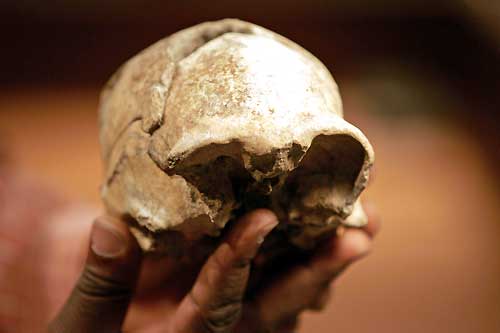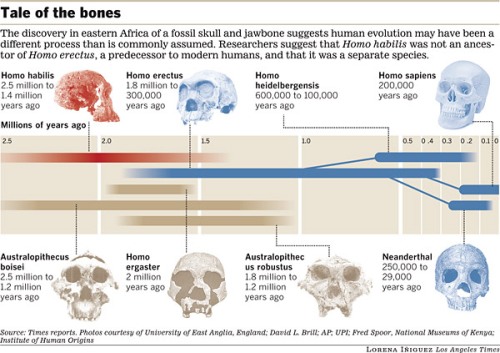We Are Not Alone
Posted by: Loren Coleman on August 12th, 2007
We are not alone. If there is any truth to the testimony of eyewitnesses worldwide, we appear to live amidst a variety of humanlike and apelike creatures whose existence has been largely ignored, forgotten, or denied, at least in recent history. Despite the crowding of the earth’s surface with our species, and the encroachment by Homo sapiens into the mountains, wildernesses, and wild places around the world, there is apparently ample room left over for our elusive cousins to hide. And they have done just that–for the most part. But as the reports of encounters accumulate, it has become increasingly clear that an understanding of these creatures lies not in myth, folklore, and legend, but ultimately, in reality. Loren Coleman and Patrick Huyghe, The Field Guide to Bigfoot and Other Mystery Primates (NY: Anomalist Books, 2006)

The news articles are easy to find, such as this one here. In 2000, Richard Leakey found an ancient complete skull of Homo erectus (shown above) within walking distance of an upper jaw of a Homo habilis, and both dated from the same general time period. That makes it unlikely that H. erectus evolved from Homo habilis, a new study states.
Few of us in cryptozoology and hominology were surprised as the entire concept of “we are not alone” underlies the notion that Homo sapiens and other unknown hominoids have lived concurrently, as well as other species of higher primates for thousands, if not millions of years.
This “breaking news” is no surprise at all. But a cool graphic came out of the discussions last week, nevertheless. There are probably some good fossil candidates in this mix for relicit hairy hominoids still existing within the modern era.

About Loren Coleman
Loren Coleman is one of the world’s leading cryptozoologists, some say “the” leading living cryptozoologist. Certainly, he is acknowledged as the current living American researcher and writer who has most popularized cryptozoology in the late 20th and early 21st centuries.
Starting his fieldwork and investigations in 1960, after traveling and trekking extensively in pursuit of cryptozoological mysteries, Coleman began writing to share his experiences in 1969. An honorary member of Ivan T. Sanderson’s Society for the Investigation of the Unexplained in the 1970s, Coleman has been bestowed with similar honorary memberships of the North Idaho College Cryptozoology Club in 1983, and in subsequent years, that of the British Columbia Scientific Cryptozoology Club, CryptoSafari International, and other international organizations. He was also a Life Member and Benefactor of the International Society of Cryptozoology (now-defunct).
Loren Coleman’s daily blog, as a member of the Cryptomundo Team, served as an ongoing avenue of communication for the ever-growing body of cryptozoo news from 2005 through 2013. He returned as an infrequent contributor beginning Halloween week of 2015.
Coleman is the founder in 2003, and current director of the International Cryptozoology Museum in Portland, Maine.










Is this site the best or what? Well I think it is and Loren keep these and all other reports that you and guys give us coming.
The more I see developments like this, the more convinced I am of the idea that just about all the old legends from around the world of other competing species, whether they’re called Trolls, Goblins, Huldufolk, Wildmen, and any number of other names and shapes and sizes, are derived from relict populations of one or more co-evolved (if you’ll pardon the term) hominid or hominoid species. Whether any or all of them still hang on in remote parts of the world is another matter, though tantalizing in its possibilities.
This is great. Scientists are actually saying Bigfoot, Almas, etc. might exist! Another step for cryptozoology!
Referring to the news article, I don’t think this find would surprise many modern anthropologists. Homo habilis has been a controversial classification from the beginning, with some anthropologists preferring to refer it to the genus Australopithecus, or maybe Paranthropus. Many have doubted that it was a direct ancestor of Homo sapiens in any case. The notion that only one member of genus Homo can exist at a given time has long been discarded.
In the “Tale of the bones” diagram shown, some anthropologists would switch the places of Homo erectus and H. ergaster.
ok, lets all just calm down a bit.
firstly, it has been accepted for decades that various hominid species co-existed for long periods of time in the past. This is no kind of ‘breaking news’ for archaeologists and palaeoanthropologists.
secondly, this is more or less completely irrelevant to the question of whether or not we presently share to planet with other hominid species. We know woolly mammoths existed contemporaneously with african and asian elephants but that fact has no bearing on whether woolly mammoths presently exist.
thirdly, this has absolutely no bearing on the truth of evolutionary theory, despite what shumway desperately wants to believe.
fourthly, the fact that members of the species homo habilis and homo erectus may have coexisted doesn’t invalidate the theory that the one evolved from the other- when new species emerge they do not necessarily do so in such a way that the species they evolved from disappears. Speciation typically occurs when a sub-population of one species becomes genetically isolated (by some mechanism) from other populations. Genetic changes then spread within this limited sub-population, that are not present in the wider population- the two populations thereby come to diverge, but it is not the case that the ‘parent’ population ceases to exist. They might become extinct, but just as likely they will continue on their own evolutionary trajectory. It is entirely possible for a sub-population of Homo habilis to evolve into Homo erectus, while a wider population of Homo habilis continues to exist.
Whether, in fact, this is what happened is a another question, but the fact of the two species co-existing is not incompatable either with the present evolutionary scenario, or with the coherence of neo-darwinian natural selection as an evolutionary mechanism.
For anybody wishing to be brought up to speed on the current state of hominid fossil evidence, the book “The Last Human” by Ian Tattersall would be a good place to start. The book demonstrates that only one known species of human on earth is a recent and exceptional development, not the norm.
Things: Well said. Brings to mind something my dad told me long ago, regarding the supposedly unsolvable question about the chicken and the egg. He said it’s not that hard. You simply consider that the chicken is the latest evolutionary mutation of a sequence, and that all mutations occur in the embryo. Therefore, obviously the egg came first.
I’ve wondered if the ancient depiction of the elves would be the way the other races (Neandertal, Heidelberg, Erectus) saw _us_.
The European Neandertals picked up the culture of the first H.s.s’ to come into Europe, that, along with the occasional evidence of interbreeding suggests that there was communication and at least trade relationships. Stories might have gotten passed back and forth along with the other cultural items.
Things-in-the-woods pretty much took the words right out of my mouth. This news is not so surprising at all from an evolutionary standpoint and the idea that some have that one species simply “passes the torch” to another only to die out is false.
New species do not simply pop into existence and then replace their precursors, but rather speciation is a gradual process that serves to cause new types of creatures to slowly branch out rather than necessarily replace the original population. It does not necessarily mean the original species dies out and does not always even mean that the two species will be in direct competition with each other as one could have broken away from the “parent” population in order to exploit different resources. This is one reason the speciation may have occurred to begin with as different isolated populations could have developed to deal with different environmental challenges and been subject to different selective pressures. The idea of two species of early humans existing side by side, even ones that evolved from another, is not unfeasible in the least.